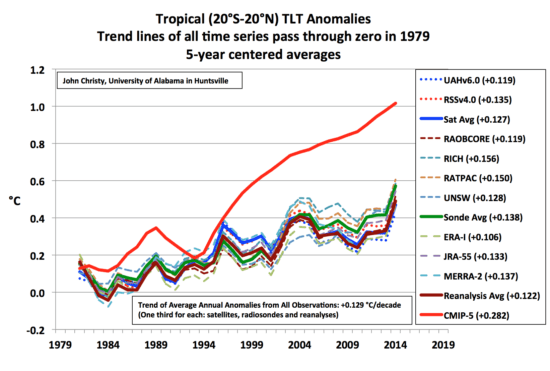But the new LT dataset (Version 4, compared to Version 3.3) didn’t really change in the tropics. This can be seen in the following plot of a variety of observational datasets and the average of 102 CMIP5 climate model simulations.

Comparison of 102 CMIP5 climate model runs (average of 32 groups) against various observations for tropical lower tropospheric temperature anomalies during 1979-2016. All yearly time series were vertically placed so that their linear trends all intersect at zero, which is the proper way to display them to compare how much warming has occurred over the entire time period. The results were then displayed as running 5 year averages.
It’s pretty clear that the models are producing too much atmospheric warming compared to satellites, radiosondes (weather balloons), and multi-observational atmospheric reanalyses. (And remember, the observations have a record warm El Nino at the end of the time series, which the model average does not. Without that, the discrepancy would be even larger).
For those who claim, But humans live at the surface, not up in the atmosphere, do those same people ignore the warming of the deep oceans, too? Or maybe they will claim, But most people don’t live in the tropics — do those people worry about Arctic sea ice melting? (The Arctic Ocean covers 2.8% of the Earth, while the tropical results in the above plot are for 35.5% of the Earth).
The fact is that how much warming is occurring in the troposphere (and in the deep oceans) tells us something about whether the climate models can be trusted. If their feedbacks are reasonably correct (which will determine how much global warming we should see in the future), the models should tell a reasonably consistent story in the atmosphere, in the ocean, at the surface, in the tropics, and outside the tropics.
Remember, the climate models are the basis for energy policy changes, and so their quantitative projections are central to the case that we must do something about our greenhouse gas emissions.

 Home/Blog
Home/Blog




